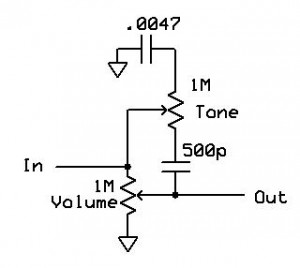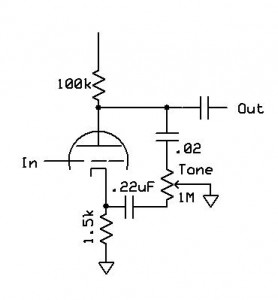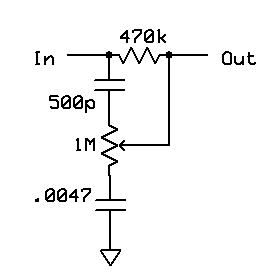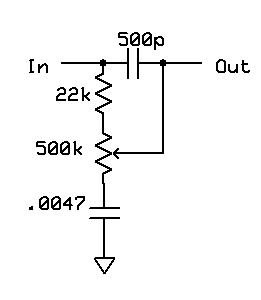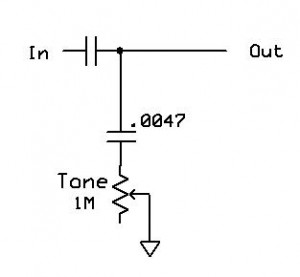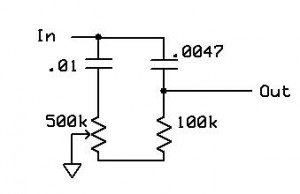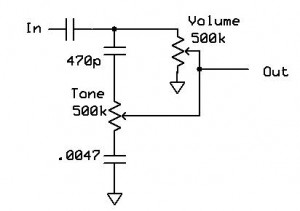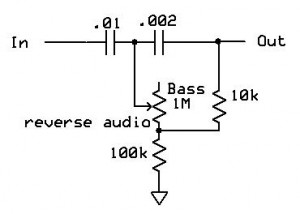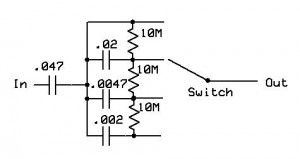This is a listing of some one knob tone controls found in tube guitar amps.
Most are designed to control the high end, meaning they either add high end or roll off high end. Toward the bottom of the list there are also two tone controls that control the bass and two that control the mids.
NOTE: The example schematics I show might have different component values than the original from the schematic.
I’ve added a note indicating if the control is complicated to implement and how “lossy” it is. More “loss” means more signal is lost and the volume is reduced.
1) Tweed
The tweed tone control is found in many amps, most notably early Fenders like the 5E3 and the Princeton 5F2A. Turning the tone control up causes it to act like a bright cap on the volume knob increasing the highs. Turning it the other way rolls off the highs.
Complexity: Simple
Loss: Very Low Loss
2) Gibson GA-30
The GA-30‘s treble control uses a small cathode bypass cap on one end of the pot to provide a treble boost. The closer the cathode bypass cap gets to ground the more high end boost there is. The other side of the pot connects a cap to ground so as you turn that way it rolls off treble to ground.
Complexity: Simple
Loss: Low Loss
3) Bitmo / Fender 5F2
The Bitmo, which takes it name from a kit for the Valve Junior, is very similar to the Tweed except instead of being built on a volume pot, it is built on a resistor. The size of the resistor can make a difference in how the effective the tone control is. I like using a 470k resistor because at it’s highest setting it simulates a traditional Marshall treble peaking circuit. The Fender 5F2 is very close to this design also but the treble cap connects at the other end of the coupling cap.
Complexity: Simple
Loss: Moderate
4) Specialist
I found this tone control in the Marshall 2046 Specialist. It’s a stand alone tone control and works reasonably well but it’s not my favourite.
Complexity: Simple
Loss: Low Loss
5) Vox – Cut
The Vox cut control is a pot and capacitor put between the two outputs of a phase inverter. The two outputs cancel each other out as the pot is turned. Without the capacitor it’s a master volume but with the capacitor its a tone
control because the capacitor limits the frequencies being cancels to the highs. Obviously this only works in a push/pull amp.
Complexity: Simple
Loss: Low Loss
6) Treble Cut
This is probably the most basic tone control and found in many old, low end amps. It’s just a pot and capacitor like the Vox Cut but it bleeds treble to ground rather than the inverting side of the phase inverter.
Complexity: Simple
Loss: Low Loss
7) 18 Watt – Normal Channel
This is the tone control from the original 18 watt and used on the normal channel. I’ve never tried this one.
Complexity: Simple
Loss: Low Loss
8) 18 Watt – Tremolo Channel
This is the more popular of the 18 Watt tone controls and it’s used the the 18 Watt Lite. It’s very similar to the Tweed tone control but it wired slightly differently and uses different value pots.
Complexity: Simple
Loss: Low Loss
9) Big Muff/Supro
In the Big Muff tone control the signal goes into both a high pass filter and a low pass filter. The pot acts a bit like a balance control between the two filters. The Supro Thunderbolt uses this tone control. Since the Supro predates the Big Muff maybe this should be called the Thunderbolt tone control?
Complexity: Moderate
Loss: Moderate
10) TMB with fixed bass and middle resistors
The classic Fender (and later copied by everyone) TMB tone stack, used in hundreds of amps, can easily be used as a single knob tone control. By replacing the bass and middle pots with resistors you are left with just the treble control. When replacing a 250k bass pot an 82k resistor works pretty well simulating a pot in the center position. 120k works pretty well for replacing a 1M bass pot in a Marshall tone stack to simulate that pot at noon. When choosing the mid resistor, usually half of the pot value is a good starting point. Make it bigger for more mids and smaller for less.
Complexity: High
Loss: High Loss
Bass Controls
11) Gibson Bass Control
Most tone controls on this list deal with the high end. This one deals with the lows. Also found in the Gibson GA30, this is a stand alone bass controls that uses capacitors of different sizes to control the bass. As the knob is turned more signal is sent through the smaller capacitor thereby reducing the low end. The Matchless Chieftain uses this bass control.
Complexity: Moderate
Loss: Moderate to Low
12) Coupling Capacitor Selector
This is also more of a bass control. Instead of a pot it uses a multi-position switch to select different size coupling capacitors. The smaller the capacitor the less low end with pass to the rest of the circuit. It’s recommended to use
high value resistors (10M) between the capacitors to eliminate “pop” noises when using the switch. The Matchless DC30 uses a switch like this.
Complexity: High (depends on how many capacitors are used)
Loss: Low Loss
Middle Controls
13) Gibson Mid Control
Another handy circuit from the Gibson GA-30. This is a stand alone mid control.
14) Framus Mid Control
This one is found in the Framus Cobra and I greatly prefer it over the Gibson mid control. It’s possible to get very nice Fender scooped tones with this one.
